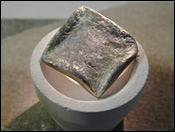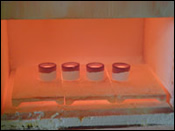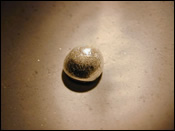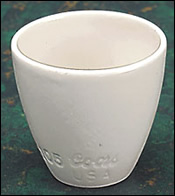"Cupellation"

Cupellation
The lead buttons are placed into a cupel. Cupels are made of bone ash
and cement or magnesium oxide. The cupels are loaded into the
cupellation kiln at 1750°F.

The
lead buttons are allowed to "open", that is to become molten. When the
cupellation is "driving" or the lead is being absorbed into the cupel
or driven off as lead oxide, the furnace is opened slightly to provide
a draft. The lead is absorbed leaving behind a tiny doré bead
containing the gold and silver.
The cupels are allowed to cool.
The doré is then removed, brushed to remove any adhering cupel material
and flattened using an anvil and bead hammer. At this point the doré is
weighed.
The doré is then finished gravimetrically or by wet chemical digestion and analysis using Atomic Absorption Spectroscopy.
Parting and Annealing
Parting
If your bead appears to be relatively pure gold, no parting is
necessary. If the presence of a significant amount of silver and/or
PGMs is indicated, proceed as follows:

To part the silver from the gold, the button must contain at least 3 times as much silver as gold.
If it does not, add sufficient assay silver to make this ratio. This is called "inquartation.
If the analysis is to be finished gravimetrically the flattened doré is
placed in a porcelain parting cup. Nitric acid (15% v/v) is added to
the parting cup and heated on a hotplate. The nitric acid dissolves the
silver leaving behind a gold sponge. The sponge is washed three times
with de-ionized water and allowed to thoroughly dry.
Then proceed to "anneal" the button as follows:

Annealing
Anneal by repeatedly hammering the bead flat and heating it in a flame
until it's red hot. Repeat heating after every couple of blows with the
hammer.
The annealed strip is then rolled into a loose coil
or "coronet," placed in a parting cup and covered with a parting
solution, a mixture of chemically pure nitric acid and distilled water,
6 parts water to I part acid, or a 6/1 ratio.
Heat the flask gently. The coronet will blacken as the hydrogen bubbles off. Do not allow it to boil too fast.
If the coronet becomes immediately black, add a little more distilled water to slow the action.
Finish
Gravimetric Instrumental: GA-AAS
Calculations
Silver correction factor (c.f.) = blank inquart wgt. (mg.) /blank doré wgt. (mg.)> Gold (oz/st) = gold (mg.) x (29.167/sample wgt.) Silver (oz/st) = (((doré (mg.) - gold (mg.)) x c.f.)- inquart wgt.) x (29.167/sample wgt.)




